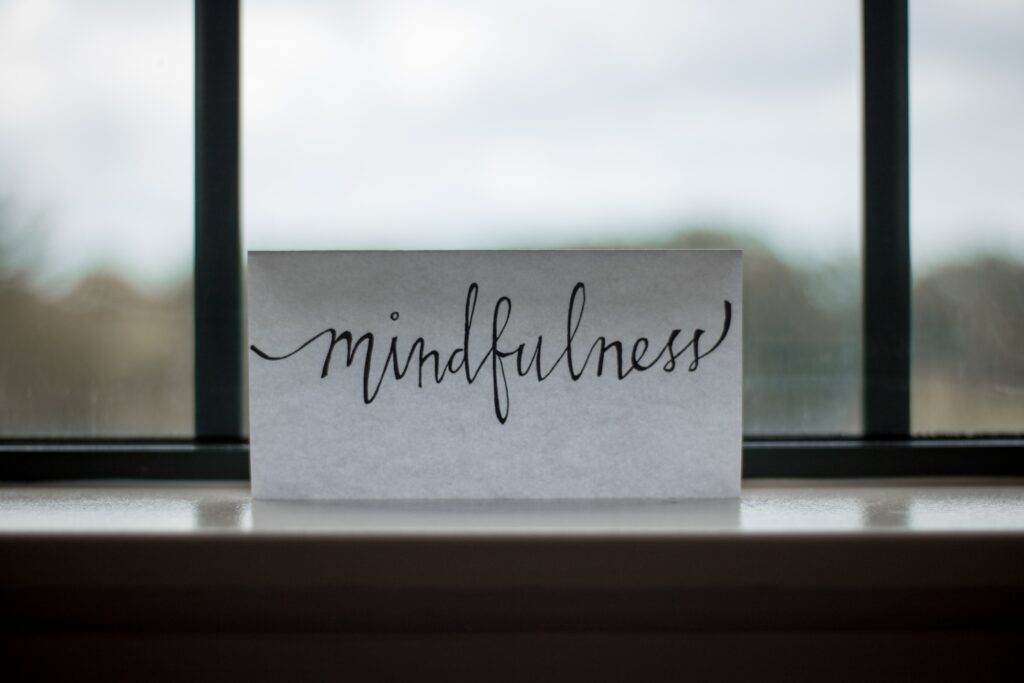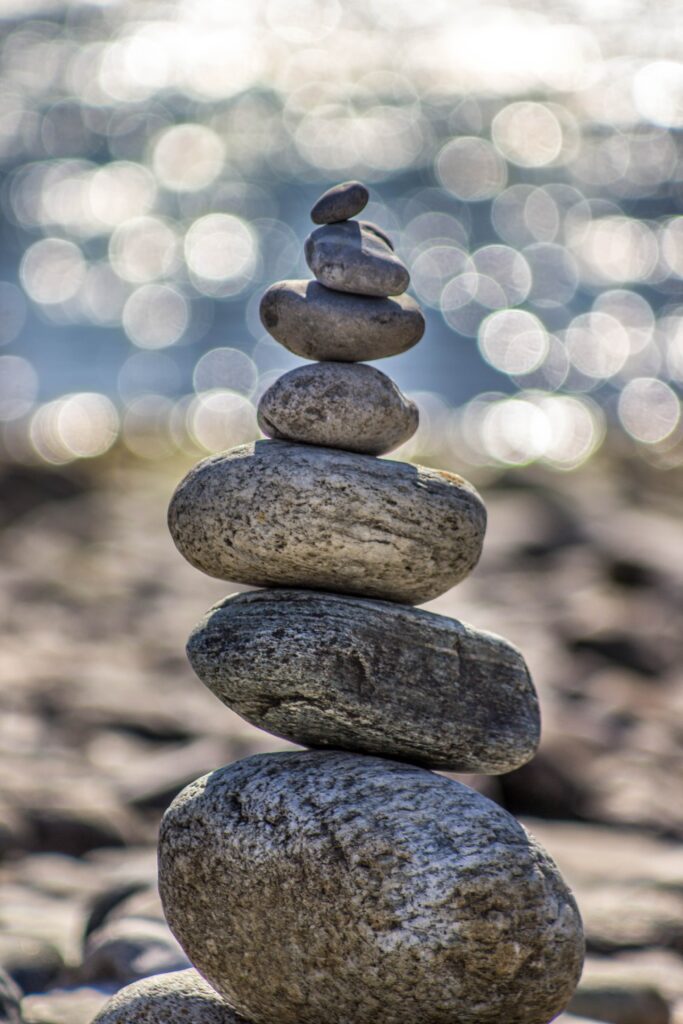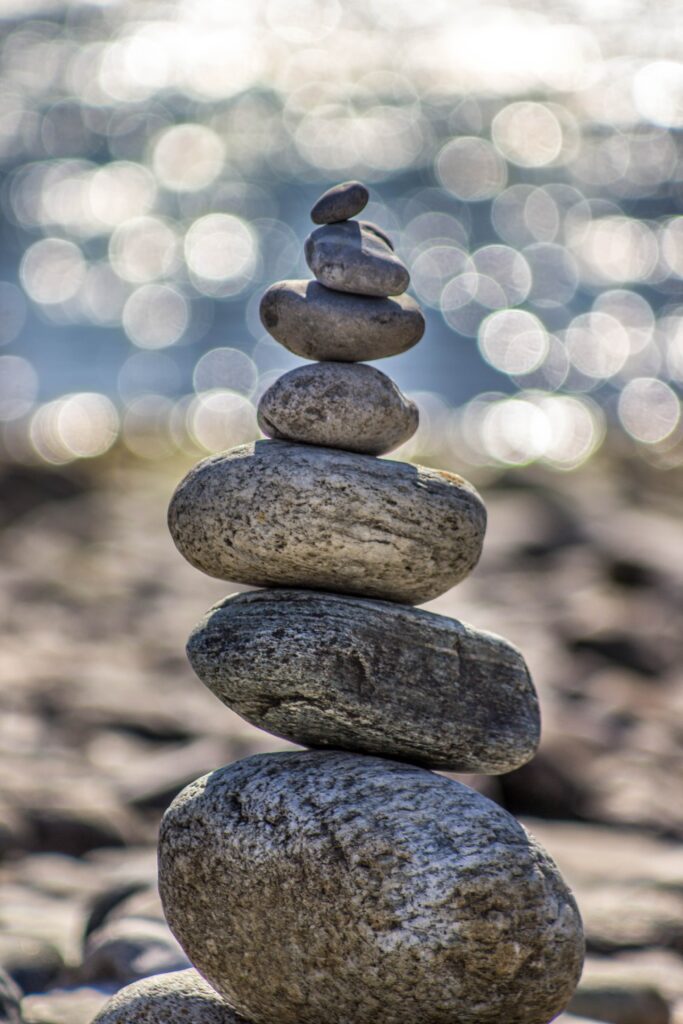In this article, you will discover a collection of powerful mindfulness techniques that can help you achieve a calm and clear mind. These techniques are simple yet effective, enabling you to cultivate a greater sense of awareness and presence in your everyday life. By practicing these mindfulness techniques, you can reduce stress, improve focus, and enhance your overall well-being. So, if you’re ready to embark on a transformative journey towards a more peaceful mind, read on to learn more about these incredible mindfulness techniques.

Breathing Techniques
Deep Abdominal Breathing
Deep abdominal breathing is a simple yet powerful technique that can help you relax, reduce stress, and bring a sense of calm to your mind and body. To practice deep abdominal breathing, find a comfortable and quiet place to sit or lie down. Place one hand on your chest and the other on your abdomen. Take a slow, deep breath in through your nose, allowing your belly to rise as you fill your lungs with air. As you exhale through your mouth, feel your belly sink back towards your spine. Continue this deep, slow breathing pattern for several minutes, focusing on the sensation of your breath moving in and out of your body.
Counting Breath
Counting breath is another effective breathing technique that can help bring your attention to the present moment and calm your mind. Find a comfortable seated position and close your eyes. Take a deep breath in and as you exhale, silently count “one” in your mind. With each subsequent breath, count up to five, and then start over again at one. If your mind starts to wander, gently bring your attention back to your breath and start counting again from one. This simple practice can help anchor your mind and bring you into a state of relaxation and focus.
Alternate Nostril Breathing
Alternate nostril breathing, also known as Nadi Shodhana, is a powerful breathing technique that can balance the energy in your body and bring a sense of calm and clarity to your mind. To practice alternate nostril breathing, sit in a comfortable position and bring your right hand up to your face. Close your right nostril with your right thumb and inhale deeply through your left nostril. At the top of your inhale, close your left nostril with your ring finger, release your right nostril, and exhale fully through your right nostril. Inhale through your right nostril, close it with your thumb, and exhale through your left nostril. Repeat this pattern for several minutes, focusing on the sensation of your breath flowing in and out of each nostril.
Body Scan Meditation
Starting at the Head
Body scan meditation is a powerful practice that helps bring awareness to the physical sensations in your body and promotes relaxation and emotional well-being. Begin by finding a comfortable position either sitting or lying down. Close your eyes and bring your attention to the top of your head. Notice any sensations or tension in your scalp, forehead, and temples. As you continue to scan down your body, bring your awareness to each area, checking in with any sensations or feelings that arise. Release any tension or tightness you may feel by simply acknowledging it and allowing it to melt away. Continue this body scan, moving down from your head to your neck and shoulders.
Moving Down to the Neck and Shoulders
Bring your attention to your neck and shoulders. Notice if there is any tightness or tension in this area. With each breath, imagine sending a wave of relaxation down your neck and shoulders, allowing any stress or tension to be released. As you continue to scan down your body, bring your awareness to your chest, arms, and hands. Notice the sensation of your breath moving in and out of your chest, and let your arms and hands relax fully.
Progressing Down the Body
Continue the body scan by bringing your attention to your abdomen, pelvis, and legs. Notice any sensations or feelings in these areas, and with each breath, invite a sense of relaxation and ease. Finally, bring your awareness to your feet, toes, and the soles of your feet. Notice the sensation of your feet connecting with the ground. Take a few moments to scan your entire body, allowing any remaining tension or stress to dissolve. This body scan meditation can help you cultivate a deep sense of relaxation and presence in your body, leaving you feeling grounded and centered.
Mindful Eating
Slow Down and Savor
Mindful eating is a practice that involves bringing full awareness to the experience of eating. In today’s fast-paced world, we often rush through meals, eating mindlessly while multitasking or focusing on other things. To practice mindful eating, start by slowing down and fully engaging with your food. Take the time to savor each bite, noticing the flavors, textures, and smells. Pay attention to the sensation of chewing and swallowing, and try to eat at a relaxed pace, savoring each mouthful. By slowing down and fully immersing yourself in the act of eating, you can cultivate a greater appreciation for food and enhance your overall sense of well-being.
Engage Your Senses
When practicing mindful eating, it’s important to engage all of your senses. Take a moment to observe the visual appearance of your food. Notice the colors, shapes, and textures. As you take a bite, pay attention to the aroma and the smell of the food. Notice how it feels in your mouth and the sound it makes as you chew. By bringing awareness to your senses, you can enhance your enjoyment of the eating experience and deepen your connection with your food.
Focus on Each Bite
One of the key aspects of mindful eating is focusing on each bite. As you take a bite of food, be fully present in the moment. Notice the taste and texture as you chew slowly and deliberately. Pay attention to any feelings of satisfaction or fullness that arise. By focusing on each bite and being fully present, you can develop a healthier relationship with food and make more conscious choices about what and how much you eat.
Visualization
Nature Imagery
Visualization is a powerful technique that involves creating a mental image or scene in your mind. Nature imagery visualization can help induce relaxation and reduce stress. Find a quiet and comfortable place to sit or lie down. Close your eyes and imagine yourself in a peaceful, natural setting. Visualize a serene forest, a calm beach, or a majestic mountaintop. Engage your senses and imagine the sights, sounds, smells, and sensations of being in that place. Take your time to fully immerse yourself in the experience, allowing the peacefulness of nature to wash over you.
Safe Space Visualization
Safe space visualization is a technique that can help you create a mental sanctuary where you can retreat to whenever you feel overwhelmed or stressed. Close your eyes and imagine your safe space. It could be a cozy cabin, a lush garden, or any place where you feel safe and at ease. Visualize the details of this space, such as the colors, textures, and sounds. Imagine yourself feeling completely relaxed and protected in this space. Whenever you need a moment of calm, you can bring your mind back to your safe space and tap into its soothing energy.
Achievement Visualizations
Achievement visualizations are a powerful tool for setting goals and manifesting your desires. Begin by clearly defining your goal or aspiration. Then, close your eyes and imagine yourself already having achieved that goal. Visualize every detail of your success – how it feels, what it looks like, and the positive impact it has on your life. Engage all of your senses and fully immerse yourself in the experience. See yourself celebrating your achievement and feeling a deep sense of satisfaction and fulfillment. By regularly visualizing your desired outcomes, you can enhance your motivation and move closer to turning your dreams into reality.

Walking Meditation
Bringing Awareness to the Movement
Walking meditation is a form of meditation practice that involves bringing awareness to the physical sensations and movements of the body while walking. Find a quiet and safe place to walk, either indoors or outdoors. Begin by standing still for a moment and bringing your attention to your breath. As you start to walk, bring awareness to the movement of your feet and legs. Notice the sensation of your feet making contact with the ground and the shifting of weight from one foot to the other. Focus on the rhythm and pace of your walking, allowing your breath to guide your steps.
Focusing on the Sensations
As you continue walking, expand your awareness to include the sensations in your body. Notice the movement of your arms and the swing of your hips. Pay attention to any sensations or tension you may feel and allow them to release with each step. Stay present and engaged with the experience of walking, letting go of any distractions or wandering thoughts that may arise. By bringing mindfulness to your walking, you can cultivate a greater sense of calm and clarity.
Staying Present and Observant
One of the key aspects of walking meditation is staying present and observant. As you walk, be fully aware of your surroundings. Notice the sights, sounds, and smells around you. Observe the sensations in your body as you move through space. If your mind starts to wander, gently bring your attention back to the present moment and the experience of walking. By practicing walking meditation regularly, you can develop a greater sense of mindfulness in your daily life and cultivate a deeper connection with your body and environment.
Gratitude Practice
Reflecting on the Good
Gratitude practice involves intentionally focusing on the positive aspects of your life and acknowledging the things you are grateful for. Take a few moments each day to reflect on the good in your life. This could be anything from small moments of joy to significant accomplishments or relationships. It can be helpful to write down your thoughts in a gratitude journal or simply take mental note of the things you are grateful for. By regularly practicing gratitude, you can shift your focus from negativity to positivity and cultivate a greater sense of contentment and happiness.
Writing in a Gratitude Journal
A gratitude journal is a powerful tool for cultivating a gratitude practice. Set aside a few minutes each day to write down the things you are grateful for. It can be as simple as jotting down three things that brought you joy or made you feel grateful that day. Write down specific details and reflect on why you are grateful for each item. By putting your gratitude into words, you can deepen the experience and strengthen your connection to the positive aspects of your life.
Expressing Gratitude to Others
Another way to practice gratitude is by expressing your appreciation to others. Take the time to thank someone who has made a positive impact on your life, whether it’s a friend, family member, coworker, or even a stranger. Write a heartfelt note, send a text message, or have a face-to-face conversation to express your gratitude. By acknowledging and appreciating others, you not only spread positivity but also strengthen your own sense of gratitude and connection with those around you.

Mindful Journaling
Stream of Consciousness Writing
Stream of consciousness writing is a powerful mindfulness practice that involves writing down your thoughts and feelings without judgment or censorship. Set aside dedicated time each day to write freely and openly. Start with a blank page and allow your thoughts to flow naturally, without any concern for grammar, spelling, or punctuation. Write down whatever comes to mind, as it arises. This practice can help you gain insight into your emotions and thought patterns, release pent-up emotions, and cultivate greater self-awareness.
Reflecting on Emotions
Mindful journaling can also be a valuable tool for reflecting on your emotions. Take a few moments each day to check in with yourself and identify any emotions you may be experiencing. Write down how you feel, describing the emotions in detail. Allow yourself to fully experience and express your emotions through your writing. By acknowledging and reflecting on your emotions, you can develop a greater understanding of yourself and ultimately find healthier ways to navigate and manage your emotions.
Noticing Daily Experiences
Mindful journaling can help you cultivate greater awareness of the present moment. Take the time to write about your daily experiences, both big and small. Notice the details of your day and reflect on the moments that stood out to you. Write down what you observed, how you felt, and any insights or lessons you gained from each experience. By taking the time to notice and reflect on your daily experiences, you can develop a deeper sense of presence and gratitude in your life.
Silent Retreats
Disconnecting from Technology
Silent retreats offer a unique opportunity to disconnect from the distractions of modern life and fully immerse yourself in a contemplative and introspective experience. One of the key aspects of silent retreats is disconnecting from technology. This means turning off your phone, avoiding social media and email, and refraining from any form of communication. By disconnecting from technology, you create a space for silence and inner reflection, allowing you to deepen your mindfulness practice and cultivate a clear and calm mind.
Committing to Silence
Another important aspect of silent retreats is committing to silence. This means refraining from speaking and engaging in verbal communication for the duration of the retreat. By observing silence, you create a container for inner stillness and deepen your ability to listen to your inner wisdom. This practice can offer profound insights and allow you to connect with your inner self on a deeper level.
Engaging in Mindful Activities
During a silent retreat, participants engage in various mindful activities such as meditation, yoga, walking, and journaling. These activities are designed to deepen your connection with the present moment and cultivate a sense of inner peace and clarity. By fully immersing yourself in these practices, you can let go of distractions and cultivate a greater sense of mindfulness and self-awareness. Silent retreats offer a unique space for personal growth and transformation, providing an opportunity to reconnect with yourself and recharge your body, mind, and spirit.
Guided Meditation
Listening to a Pre-Recorded Guided Meditation
Guided meditation is a form of meditation practice that involves following the instructions of a teacher or guide. Pre-recorded guided meditations are widely available and can be accessed online or through apps. These guided meditations provide a structured and supportive framework for your meditation practice. Simply find a quiet and comfortable place to sit or lie down, play the guided meditation, and allow yourself to be led through the practice. Follow the instructions of the guide and let their words and guidance support you in cultivating a calm and clear mind.
Following a Teacher’s Instructions
Another way to practice guided meditation is by following the instructions of a live teacher or practitioner. Many meditation centers and retreats offer guided meditation sessions led by experienced instructors. These sessions provide an opportunity to receive personal guidance and support in your practice. Simply find a meditation center or group in your area, attend a session, and follow the instructions of the teacher. By participating in guided meditation with a live teacher, you can deepen your practice and receive feedback and support along the way.
Using Visualization Techniques
Guided meditations often incorporate visualization techniques to help you relax and focus your mind. Visualization involves creating a mental image or scene in your mind’s eye. During a guided meditation, the teacher may guide you through visualizing a peaceful and calming scene, such as a serene beach or a tranquil forest. By engaging your senses and fully immersing yourself in the visualization, you can enhance your relaxation and deepen your meditation experience. Visualization techniques can be a powerful tool in calming the mind and cultivating a sense of inner peace.
Digital Detox
Setting Boundaries with Technology
A digital detox involves intentionally taking a break from technology and setting boundaries around its use. Start by considering how and when you use technology in your daily life. Identify areas where you feel technology may be causing stress or negatively impacting your well-being. Set clear boundaries and establish specific times during the day when you will disconnect from technology. This could include turning off your phone during meals or before bedtime, or designating certain days of the week as “tech-free” days. By setting boundaries and taking regular breaks from technology, you can reduce stress, improve sleep, and cultivate a more balanced and mindful relationship with technology.
Taking Regular Tech Breaks
Taking regular tech breaks throughout the day is another effective way to practice digital detox. During these breaks, intentionally disconnect from all screens and engage in offline activities. This could include going for a walk, reading a book, or engaging in a hobby or creative pursuit. By taking breaks from technology, you give your mind and body a chance to rest and rejuvenate, allowing you to return to your tech usage with greater focus and clarity.
Engaging in Offline Activities
Engaging in offline activities is an essential aspect of a digital detox. Make a conscious effort to prioritize activities that don’t involve technology. This could include spending time in nature, practicing a hobby or craft, connecting with loved ones in person, or engaging in physical exercise. By immersing yourself in offline activities, you can reconnect with the present moment and cultivate a greater sense of mindfulness and well-being.
Incorporating mindfulness techniques into your daily life can help you cultivate a calm and clear mind, reduce stress, and enhance your overall well-being. Whether you choose to practice breathing techniques, body scan meditation, mindful eating, visualization, walking meditation, gratitude practice, mindful journaling, silent retreats, guided meditation, or engage in a digital detox, each technique offers unique benefits and supports your journey towards a more present and mindful life. Experiment with different techniques and find what resonates with you. Remember, mindfulness is a lifelong practice, so be patient and gentle with yourself as you explore these techniques and integrate them into your daily routine.




